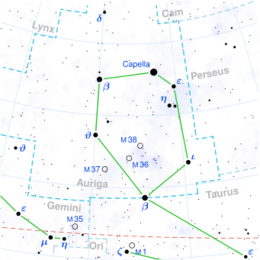Astronomy:Psi5 Aurigae
| Observation data Equinox J2000.0]] (ICRS) | |
|---|---|
| Constellation | Auriga |
| Right ascension | 06h 46m 44.3388s[1] |
| Declination | +43° 34′ 38.737″[1] |
| Apparent magnitude (V) | 5.25[2] |
| Characteristics | |
| Spectral type | G0 V[3] |
| U−B color index | +0.06[2] |
| B−V color index | +0.570[4] |
| Astrometry | |
| Radial velocity (Rv) | –24[5] km/s |
| Proper motion (μ) | RA: –1.07[1] mas/yr Dec.: +164.25[1] mas/yr |
| Parallax (π) | 60.56 ± 0.73[1] mas |
| Distance | 53.9 ± 0.6 ly (16.5 ± 0.2 pc) |
| Absolute magnitude (MV) | 4.13[5] |
| Details | |
| Mass | 1.079[6] M☉ |
| Radius | 1.18[6] R☉ |
| Surface gravity (log g) | 4.06[3] cgs |
| Temperature | 5,989[3] K |
| Metallicity [Fe/H] | +0.05[3] dex |
| Rotational velocity (v sin i) | 5.03[4] km/s |
| Age | 3.2[5] Gyr |
| Other designations | |
| Database references | |
| SIMBAD | data |
Psi5 Aurigae (ψ5 Aur, ψ5 Aurigae) is a star[8] in the northern constellation of Auriga. It is faintly visible to the naked eye with an apparent visual magnitude of 5.25.[2] Based upon parallax measurements made during the Hipparcos mission, this star is approximately 53.9 light-years (16.5 parsecs) distant from Earth.[1] There is an optical companion[8] which is 36 arcseconds away and has an apparent magnitude of +8.4.
It used to be known to be part of a much bigger constellation named Telescopium Herschelii before it was unrecognized by the International Astronomical Union (IAU).
Characteristics
The spectrum of this star shows it to be a G-type main sequence star with a stellar classification of G0 V.[3] Thought to be around 4 billion years old, it is similar in size, mass,[6] and composition to the Sun,[3] making this a solar analog. It is radiating energy into space at an effective temperature of 5,989 K,[3] giving it the golden-hued glow of a G-type star.[9]
Debris disk
Observation in the infrared shows an excess emission that suggests the presence of a circumstellar disk of dust, known as a debris disk. This material has a mean temperature of 60 K, indicating that it is orbiting at a distance of about 29 astronomical units from the host star. The dust has about half the mass of the Moon and is around 600 million years old.[10] The star is being examined for evidence of extrasolar planets,[11] but none have been found so far.
See also
References
- ↑ 1.0 1.1 1.2 1.3 1.4 1.5 van Leeuwen, Floor (November 2007), "Validation of the new Hipparcos reduction", Astronomy and Astrophysics 474 (2): 653–664, doi:10.1051/0004-6361:20078357, Bibcode: 2007A&A...474..653V. Note: see VizieR catalogue I/311.
- ↑ 2.0 2.1 2.2 Argue, A. N. (1966), "UBV photometry of 550 F, G and K type stars", Monthly Notices of the Royal Astronomical Society 133 (4): 475, doi:10.1093/mnras/133.4.475, Bibcode: 1966MNRAS.133..475A.
- ↑ 3.0 3.1 3.2 3.3 3.4 3.5 3.6 Cenarro, A. J. et al. (January 2007), "Medium-resolution Isaac Newton Telescope library of empirical spectra - II. The stellar atmospheric parameters", Monthly Notices of the Royal Astronomical Society 374 (2): 664–690, doi:10.1111/j.1365-2966.2006.11196.x, Bibcode: 2007MNRAS.374..664C.
- ↑ 4.0 4.1 Martínez–Arnáiz, R. et al. (September 2010), "Chromospheric activity and rotation of FGK stars in the solar vicinity. An estimation of the radial velocity jitter", Astronomy and Astrophysics 520: A79, doi:10.1051/0004-6361/200913725, Bibcode: 2010A&A...520A..79M, http://eprints.ucm.es/37826/1/davidmontes17libre.pdf, retrieved 2018-11-04.
- ↑ 5.0 5.1 5.2 Holmberg, J.; Nordström, B.; Andersen, J. (July 2009), "The Geneva-Copenhagen survey of the solar neighbourhood. III. Improved distances, ages, and kinematics", Astronomy and Astrophysics 501 (3): 941–947, doi:10.1051/0004-6361/200811191, Bibcode: 2009A&A...501..941H.
- ↑ 6.0 6.1 6.2 Takeda, Genya et al. (February 2007), "Structure and Evolution of Nearby Stars with Planets. II. Physical Properties of ~1000 Cool Stars from the SPOCS Catalog", The Astrophysical Journal Supplement Series 168 (2): 297–318, doi:10.1086/509763, Bibcode: 2007ApJS..168..297T.
- ↑ "psi05 Aur". SIMBAD. Centre de données astronomiques de Strasbourg. http://simbad.u-strasbg.fr/simbad/sim-basic?Ident=psi05+Aur.
- ↑ 8.0 8.1 Eggleton, P. P.; Tokovinin, A. A. (September 2008), "A catalogue of multiplicity among bright stellar systems", Monthly Notices of the Royal Astronomical Society 389 (2): 869–879, doi:10.1111/j.1365-2966.2008.13596.x, Bibcode: 2008MNRAS.389..869E.
- ↑ "The Colour of Stars", Australia Telescope, Outreach and Education (Commonwealth Scientific and Industrial Research Organisation), December 21, 2004, http://outreach.atnf.csiro.au/education/senior/astrophysics/photometry_colour.html, retrieved 2012-01-16.
- ↑ Rodriguez, David R.; Zuckerman, B. (February 2012), "Binaries among Debris Disk Stars", The Astrophysical Journal 745 (2): 147, doi:10.1088/0004-637X/745/2/147, Bibcode: 2012ApJ...745..147R.
- ↑ Grether, Daniel; Lineweaver, Charles H. (April 2006), "How Dry is the Brown Dwarf Desert? Quantifying the Relative Number of Planets, Brown Dwarfs, and Stellar Companions around Nearby Sun-like Stars", The Astrophysical Journal 640 (2): 1051–1062, doi:10.1086/500161, Bibcode: 2006ApJ...640.1051G.
External links
 |



